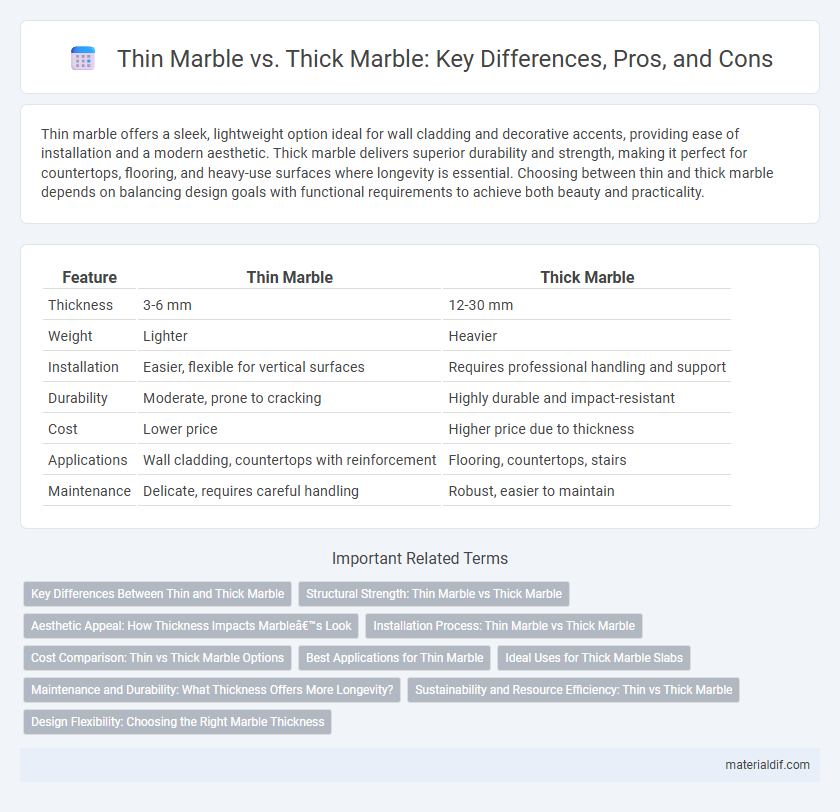Thin marble offers a sleek, lightweight option ideal for wall cladding and decorative accents, providing ease of installation and a modern aesthetic. Thick marble delivers superior durability and strength, making it perfect for countertops, flooring, and heavy-use surfaces where longevity is essential. Choosing between thin and thick marble depends on balancing design goals with functional requirements to achieve both beauty and practicality.
Table of Comparison
| Feature | Thin Marble | Thick Marble |
|---|---|---|
| Thickness | 3-6 mm | 12-30 mm |
| Weight | Lighter | Heavier |
| Installation | Easier, flexible for vertical surfaces | Requires professional handling and support |
| Durability | Moderate, prone to cracking | Highly durable and impact-resistant |
| Cost | Lower price | Higher price due to thickness |
| Applications | Wall cladding, countertops with reinforcement | Flooring, countertops, stairs |
| Maintenance | Delicate, requires careful handling | Robust, easier to maintain |
Key Differences Between Thin and Thick Marble
Thin marble typically ranges from 3mm to 6mm in thickness, making it lightweight and easier to install on vertical surfaces, while thick marble ranges from 15mm to 30mm, providing superior durability and strength suited for high-traffic areas like flooring and countertops. Thick marble offers enhanced resistance to impact, scratching, and temperature variations, whereas thin marble is more flexible but less robust, often requiring reinforcement. Pricing also varies, with thick marble generally more expensive due to higher material volume and longer manufacturing processes.
Structural Strength: Thin Marble vs Thick Marble
Thin marble offers elegant aesthetics with reduced weight, making it suitable for decorative applications but generally has lower structural strength compared to thick marble. Thick marble provides superior durability and load-bearing capacity, ideal for high-traffic flooring, countertops, and structural components requiring enhanced resistance to cracking and chipping. Choosing the appropriate thickness depends on balancing design requirements with the mechanical strength necessary for long-lasting performance.
Aesthetic Appeal: How Thickness Impacts Marble’s Look
Thin marble offers a sleek, modern aesthetic with a delicate, translucent quality that highlights natural veining patterns, enhancing visual depth and elegance. Thick marble provides a robust, luxurious appearance with pronounced edges and a solid feel, emphasizing the stone's texture and weight for a more dramatic statement. The choice between thin and thick marble significantly influences interior design, balancing subtle refinement against bold opulence.
Installation Process: Thin Marble vs Thick Marble
Thin marble offers a streamlined installation process due to its lightweight nature, allowing for easier handling, faster setting times, and reduced structural support requirements. Thick marble demands more labor-intensive procedures, including reinforced subfloor preparation and heavier lifting, which increase installation time and cost. Choosing the correct thickness impacts both the installation complexity and long-term durability of marble surfaces.
Cost Comparison: Thin vs Thick Marble Options
Thin marble typically costs less than thick marble due to reduced material usage and lighter shipping expenses. Thick marble slabs offer greater durability and a premium aesthetic, which can increase installation and overall project costs. Choosing thin marble is a cost-effective option for decorative applications, while thick marble suits high-traffic or structural needs where long-term investment is prioritized.
Best Applications for Thin Marble
Thin marble, typically ranging from 1/4 to 1/2 inch in thickness, excels in applications requiring lightweight material with aesthetic appeal, such as wall cladding, backsplashes, and furniture inlays. Its reduced thickness allows for easier installation and curved surfaces, making it ideal for decorative panels and intricate design elements in both residential and commercial interiors. Thin marble is less suited for flooring or heavy-traffic areas where durability and impact resistance are critical.
Ideal Uses for Thick Marble Slabs
Thick marble slabs, typically measuring 2 to 3 centimeters or more, offer exceptional durability and structural strength, making them ideal for high-traffic areas like kitchen countertops, commercial flooring, and bathroom vanity tops. Their increased thickness provides enhanced resistance to chipping, cracking, and heavy impact compared to thin marble slabs, ensuring longevity in demanding environments. Thick marble slabs also support complex edge profiles and heavy installations, which are essential for custom architectural features and luxury interior designs.
Maintenance and Durability: What Thickness Offers More Longevity?
Thick marble slabs typically provide greater durability and require less frequent maintenance due to their increased resistance to cracking, chipping, and wear over time. Thin marble, while aesthetically pleasing and easier to install, is more susceptible to damage and often demands careful handling and more frequent sealing to maintain its appearance. The enhanced longevity of thick marble makes it a preferred choice for high-traffic areas and surfaces exposed to heavy use.
Sustainability and Resource Efficiency: Thin vs Thick Marble
Thin marble reduces material consumption and energy use during extraction and transportation, enhancing sustainability by minimizing carbon footprint. Thick marble requires more raw resources and generates higher waste, impacting environmental balance negatively. Efficient use of thin marble supports resource conservation and sustainable construction practices.
Design Flexibility: Choosing the Right Marble Thickness
Thin marble offers enhanced design flexibility due to its lightweight nature, making it ideal for vertical applications like wall cladding and intricate decorative elements where ease of handling is crucial. Thick marble provides durability and structural integrity, suitable for high-traffic surfaces such as flooring and countertops that demand long-lasting strength. Selecting the right marble thickness depends on balancing aesthetic goals with functional requirements to achieve optimal performance and design impact.
Thin Marble vs Thick Marble Infographic

 materialdif.com
materialdif.com